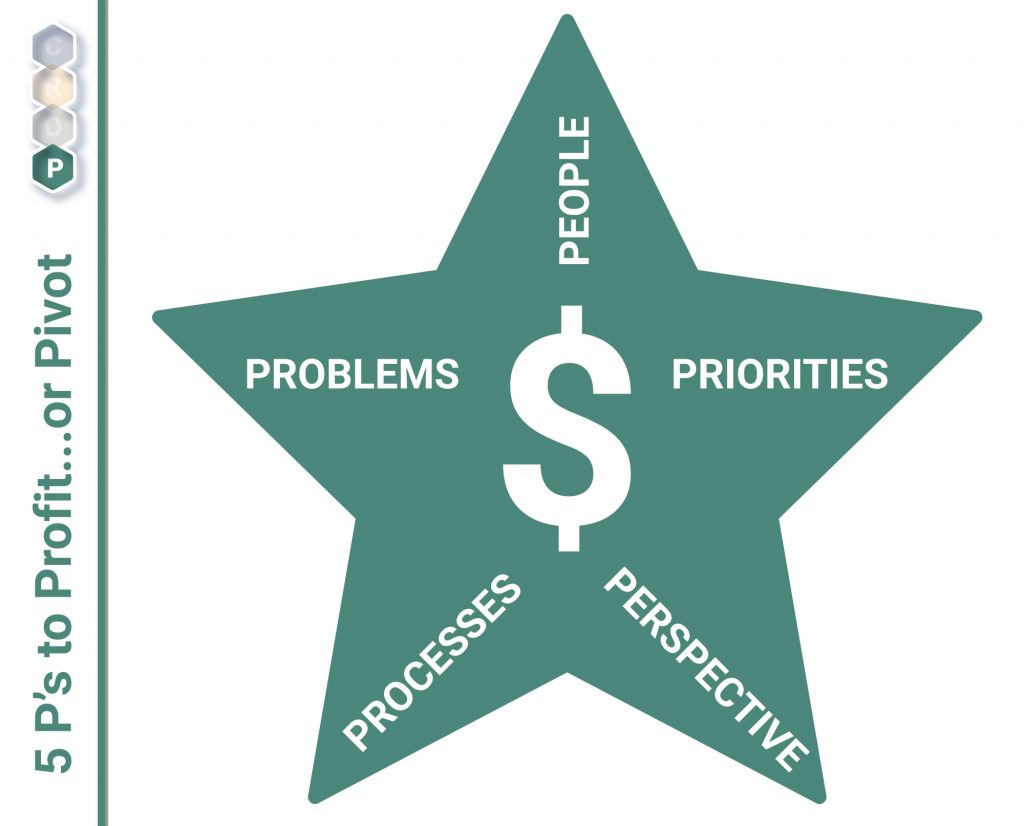The final area of focus in the CROP model is Profit…or Pivot. How I came across 5 P’s for this area is a bit of a long story involving a layover in New York, watching a random hotel TV interview, and a lot of subsequent experience so I’ll cut to the chase: in order to profit, it’s essential to find the intersection of the right people, problems, priorities, processes, and perspective. Five P’s to remember. I’ve diagramed it as a five-sided star, with profit in the middle. You can turn the star to put anything on top, and everything intersects. If you’re not finding the balance between these concepts, and you’ve optimized operations, then it’s time to pivot. Something is just not working and it’s time to create a new hypothesis, validate it, and move in a new direction.

Let’s look at the P’s in more depth. As with each of the other tools in the CROP model, the 5 P’s have a reciprocal and synergistic relationship with each other. As you focus on one P, you’ll see how it influences the others.
People
You may have noticed that your team is a recurring point of optimization. Teams evolve. Ideally, the same team you formed your concept and runway with will remain with you through operations and profit. But that rarely happens. As your business evolves, so will your needs. It’s good to get new insights into your challenges and fresh eyes on problems. Diversity in thoughts, opinions, and experiences turn energetic, respectful conflict into a productive ecosystem for discovery. It’s healthy and so satisfying to disagree (or agree!), communicate effectively, and commit together as a team. Your people influence, and are influenced by your problems, priorities, processes, and perspective. So it’s essential to have the right people on the team and at the table as you work to solve customer pains.
Problems
There will always be problems. The question is “do you have the right problems?” Producing at scale can be a problem. But it’s the right problem. Onboarding more people than anticipated is a problem, but it’s a right problem. The trick is to prevent your solution from getting mired in the wrong problems (lawsuits…churn…hemorrhaging cash…oh my!) and focus on having the right problems. This is much easier said than done, and that’s why it’s an important part of profiting or pivoting.
Priorities
Setting the right priorities is an ever-shifting battle. Whether you use a MOKR/OKR (Mission, Objective, Key Result), KPI (Key Performance Indicator) or other framework, there should always be one key metric that brings all the work effort into alignment to effect significant change. This helps channel energy and keep people moving in the same direction.
But it’s also important to always keep in mind the ultimate desired outcome: leveraging your solution to solve problems for people. I’ve seen people intentionally make short-sighted prioritization choices just to be rewarded with a bonus or other incentive for hitting the current goal.
Take for example a scenario where the quarterly objective is to add 1,000 new users. A highly motivated team will pull out all the stops to hit this number, especially if there’s an additional incentive tied to it such as a bonus. But the right team with the right priorities will also consider churn and LTV. Yes, we want 1,000 new users. But ultimately the goal is not to keep them, and not churn out 1,500 customers, or decrease LTV in the process. The right team will see these considerations, point out work that might seem to meet the current objective but have long-term ramifications that don’t result in a profitable solution.
Processes
Sometimes the way we do things is important. And sometimes it’s not. Optimizing processes for profit is all about understanding which processes serve us and which do not. One of my favorite parts of the Agile manifesto is valuing people over process. What this means is that people are human and we all have quirks. Processes need to make sense for our situation and our people, priorities, and perspective. We should never do things just because that’s the way an expert recommended it, or because that’s the way it’s always been done here. The right people with the right priorities will have the freedom to communicate what works for them and what does not. Working together, dynamic teams create functional processes that strike a balance between procedure, housekeeping, and output. And that can be very profitable.
Perspective
The final P in Profit or Pivot is perspective. Here again, having the right people, problems, priorities and processes is critical to gaining the right perspective. During the concept phase of CROP, customer pain points were identified, a solution with unique value was proposed, distribution channels were assigned, and budgets were formulated. Do those still ring true, now that you have a different perspective? What’s the market perspective on your solution? Consider your customers’ point of view for your people, problems, priorities, and processes. By looking at things from different angles, gathering, collating, and analyzing data, new hypothesis could surface and new ideas may come to light.
Walking through these five P’s helps us identify areas of opportunity to profit or pivot. It comes down to this question: If you could go back to the concept stage and do it all again, would you? What would you do differently?
And that’s the CROP cycle starting again.
0 Comments